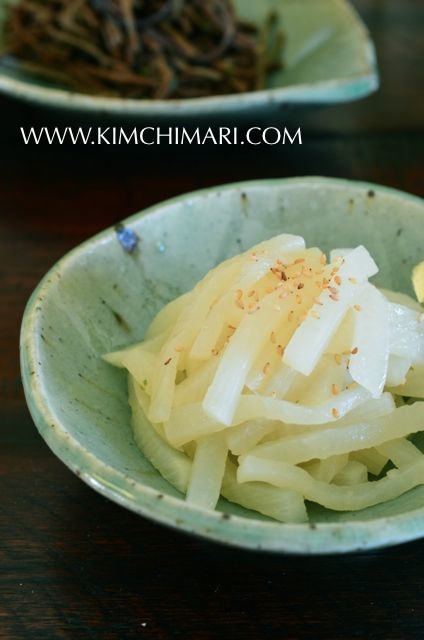
Sam (pronounced saam) means 3 in Korean and saek means color. So samsaek namul means vegetables of 3 colors: specifically white, black/brown and green. I will be writing a 3 series post about this dish since it’s actually 3 different dishes often plated in one. Today’s post will be on White radish namul.
Recently, all of a sudden, I had this craving for mu namul (무나물) – a surprisingly delicious Korean radish namul/banchan/side dish. The most yummy memories of mu/moo namul come from my visits to Dr. Okgil Kim’s country side home during my college years. Dr. Okgil Kim is a well respected Korean woman educator who was also the 8th president of Ewha Woman’s university (1961-1979) – my alma mater – and the Secretary of Education. After having served in the public office, she retired to a beautiful but humble home in the area of Munkyung Saejae(문경세재) .
Dr. Kim is someone I have the utmost respect for. Both in terms of the work that she did to advance woman’s status and education in Korea and also in terms of how she lived her everyday life. She was a counselor, comforter, super generous human being who was also bold and free spirited. Living as a single working woman was not an easy feat in those days and she overcame it with humor which was a rarity – and is still today to some extent -in Korean society.
I am not sure how our family became close to her other than the fact that my parents and Dr. Kim all fled from North to South Korea during the Korean war. Our family shared similar tastes in food and also temperament which is North Korean style – honest, no nonsense, no frills, just see and tell things like it is.. Perhaps that’s where some of my candid stories and opinions come from.. :)).
The doors to her home in Munkyung Saejae province was always open to any visitor that wanted to come and rest, eat or sleep..It was truly a place for all to enjoy. Anyway, where is this all leading? Well, one of Dr. Kim Okgil’s favorite banchan was the radish namul. Strangely for a Korean, she did NOT like garlic or overly spicy dishes. Some people thought foods served at her home were even kind of bland but I thought they were simply down to earth good – just like the owner of the home.
Going back to Samseak Namul..here is a list of vegetables that make up each color.
- For white: root vegetables like bellflower roots (도라지 Doraji) and radish (무나물 munamul)
- For black: vegetable stems like fiddlehead ferns (고사리 gohsari) and sweet potato stems(고구마줄기 goguma julki)
- For green: leaf vegetables like spinach(시금치 sikeumchi), water dropwart(미나리 minari) and perilla leaves (깻잎 kkaetnip)
I also love bellflower roots and please refer to my detailed Doraji Namul recipe. And check my bibimbap post on how it is used as a topping.
The recipe below was based on my sister #2’s memory from the time she helped out at Dr Kim’s kitchen during those times. Thank you Sis!
Servings: 3 Cooking Time: 10 min Difficulty: easy
Ingredients
- 1.5 lb Korean radish
- 1/2 Cup water
- 1 tsp grated ginger juice
- 1/4~1/2 tsp sea salt
- 1 tsp sesame oil (or perilla seed oil)
- 1 tsp vegetable oil
- sesame seeds for sprinkling

- Cut radish into 2 inch (5 cm) thick chunks.
How to peel radish for Korean mu namul - Peel the radish with a knife. Korean radish has a thick skin so using a regular peeler will be more work (probably two layers or more).
Slicing radish for mu namul (Korean Radish Saute/Namul/side dish) - Slice radish chunk vertically into 1/2~3/4 in (1cm) thick slices. I made mine thick but you can certainly slice them thinner. Don’t slice them too thin because radish will break easily if too thin.
- Cut radish slices into sticks.
Radish sticks for Korean Radish Saute (mu namul) side dish - Add oil to pan and sauté for 3 min on medium heat. Add 1/2 C water and lower heat, cover and cook for 5-6 min. Stirring occasionally.
- Add 1/4~1/2 tsp sea salt. Squeeze 1 tsp fresh grated ginger to add the juice only. You can use chopped garlic instead but I like ginger better.
Radish sauteed in pan (mu namul) - Sauté over med high heat until radishes are cooked and liquid evaporates. Radish sticks should be semi-transparent when cooked. Finish by adding sesame oil or perilla seed oil (들기름 deul kireum), sprinkling of sesame seeds.
And there you have it! It is amazingly simple to make but just like how french style glazed root vegetables like carrots and turnips can taste amazing when cooked properly, Korean radishes can taste simply divine when made this way. Any bitterness or peppery flavor goes away while the sauteeing really brings out the best of the radish: slightly sweet and soothing with the soft yet slightly crunchy texture being perfectly balanced. Mu/moo namul is a side dish(banchan) that goes great with any Korean meal.
Storage – store in refrigerator up to a week
Make a quick and yummy bibimbap by mixing with some warm rice (multi-grain is even better), mu namul and yangnyeom jang (soy sauce, sesame oil, chopped green onions and garlic and sesame seeds) to make a fabulous gluten-free, vegetarian meal.
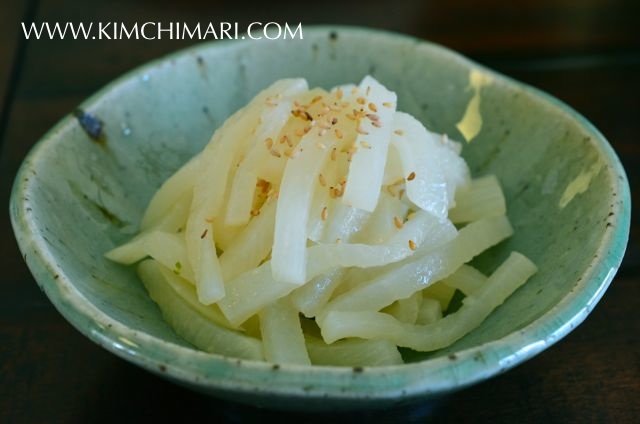
Three Color Vegetables (Samsaek Namul) – White
Ingredients
- 1.5 lb Korean radish
- 0.5 cup water
- 1 tsp grated ginger juice
- 1/4-1/2 tsp Sea Salt (Trader Joe's)
- 1 tsp sesame oil (or perilla seed oil)
- 1 tsp vegetable oil
- Sesame seeds for sprinkling
Instructions
- Cut radish into 2 inch (5 cm) thick chunks.
- Peel the radish with a knife. Korean radish has a thick skin so using a regular peeler will be more work (probably two layers or more).
- Slice radish chunk vertically into 1/2~3/4 in (1cm) thick slices. I made mine thick but you can certainly slice them thinner. Don’t slice them too thin because radish will break easily if too thin.
- Cut radish slices into sticks.
- Add the oil to pan and sauté for 3 min on medium heat. Add 1/2 cup water and lower the heat, cover and cook for 5-6 min. Stir occasionally.
- Add 1/4-1/2 tsp sea salt. Squeeze 1 tsp fresh grated ginger to add the juice only. You can use chopped garlic instead but I like ginger better.
- Sauté over med high heat until radishes are cooked and the liquid evaporates. Radish sticks should be semi-transparent when cooked. Finish by adding sesame oil or perilla seed oil (deul kireum) and a sprinkling of sesame seeds.
- Store in the refrigerator for up to a week.
Nutrition Information:
Here are links to other two color vegetables: Brown Bracken Fiddelheads and White Radish Namul.
Enjoy!
Follow Me on INSTAGRAM or my Facebook Page to share, support and ask everything about Korean food with others just like you!
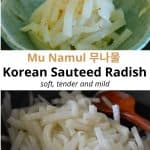
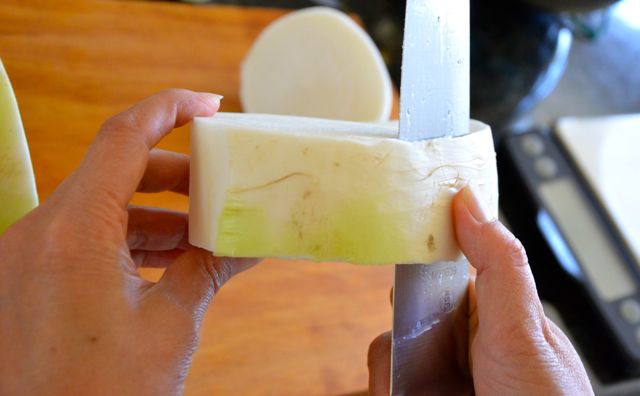
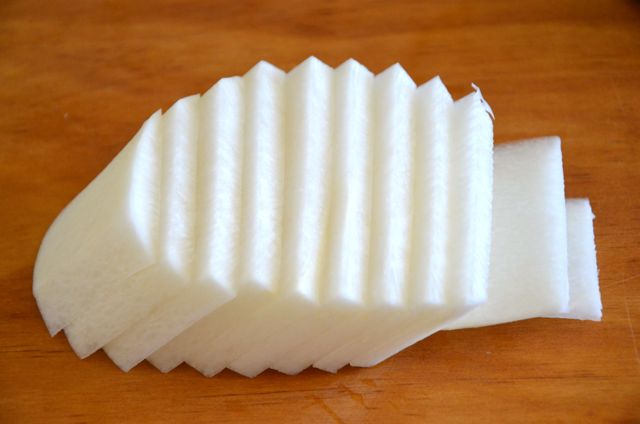
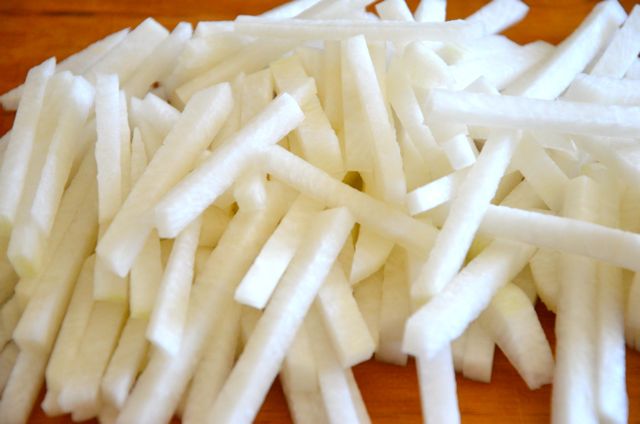
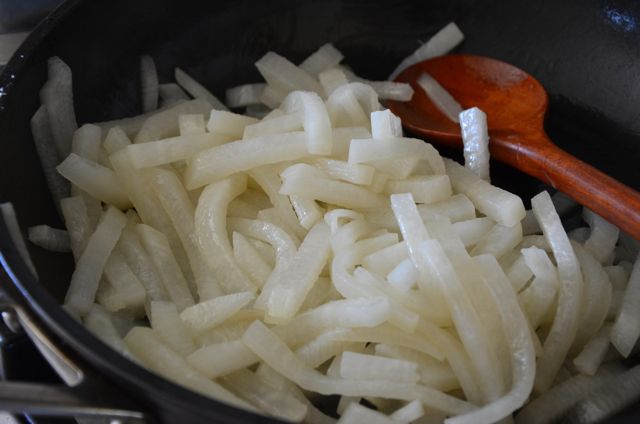
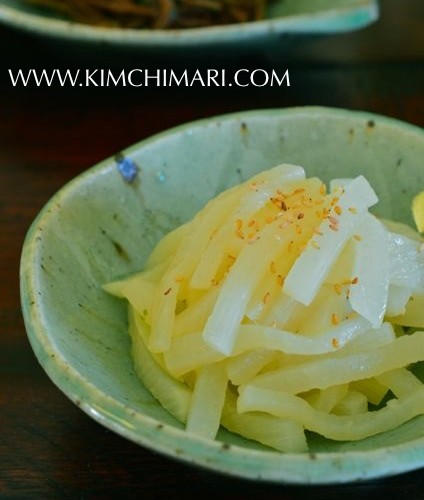
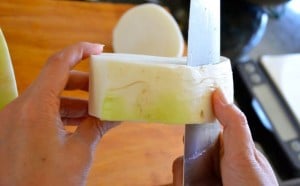
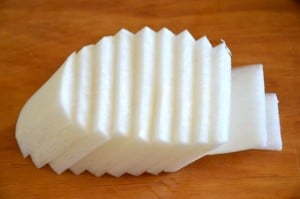
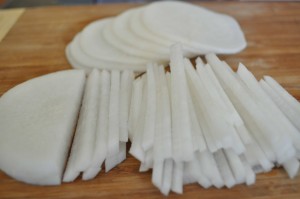
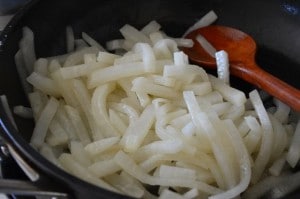
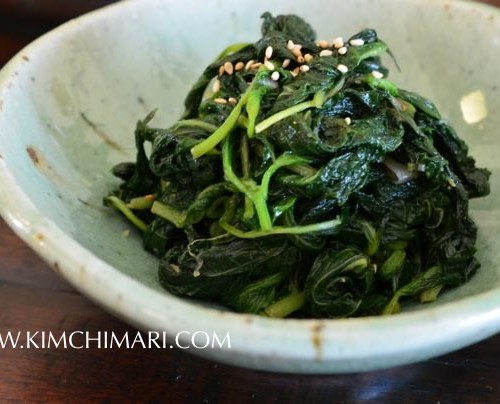

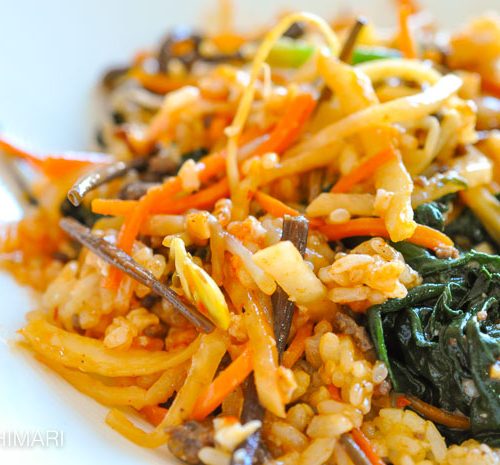
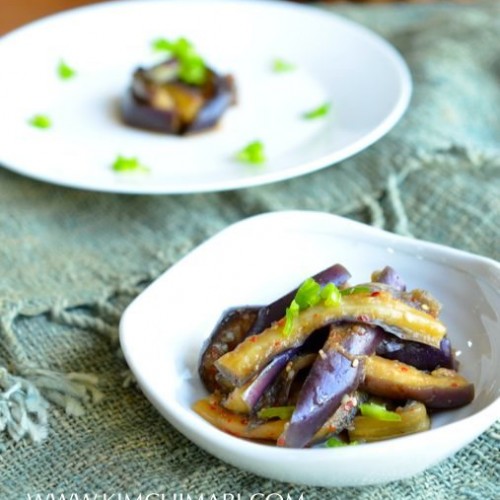
















As a Canadian living in Korea with my Korean husband, I can’t tell how helpful the information you’re sharing is! And I really appreciate that most often you provide the 한글 words, not just the phonetic spelling in English.
The recipe says to add 1/2 cup of water to the pan in step 5, but I can’t find what happens with the other half. Did I miss something? Thank you in advance.
Hi Lori,
So happy to hear that and glad it’s helpful. And I’m sorry, I don’t know what happened – it should just be 1/2 cup water. But adjust as needed. If you are in Korea and the radish si really fresh, you may not need as much water. But basically, you want to cook it until most of the water is gone and just soft enough but not too mushy. Enjoy! Thank you – I fixed it.
Love the background story for this recipe. I tend to buy mu namul ready made because it’s hard to use up a whole radish! But the shop ones are very different to your recipe so I will try it out soon as it sounds delicious!
thank you for liking my story! Yes, it is hard to use the whole radish, isn’t it? Try making some soy bean paste soup with it – it’s one of my favorite. Instead of making Cabbage soup, you make it with radish. Hope it turns out yummy for you~
The radishes are just so big! And there is just two of us plus my OH doesn’t like them…. I think I have used the radish in a beef & radish soup which was very nice. Can’t remember whether I used soy bean paste in it but don’t think so, so will try that out as well.